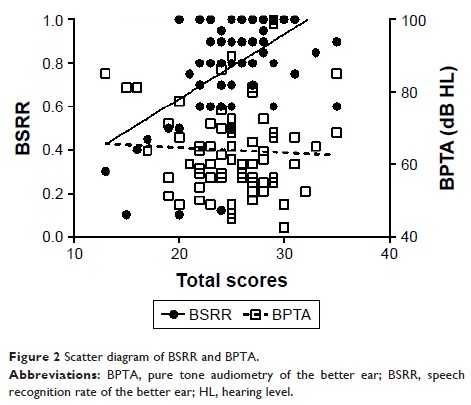108384
论文已发表
注册即可获取德孚的最新动态
IF 收录期刊
- 3.4 Breast Cancer (Dove Med Press)
- 3.2 Clin Epidemiol
- 2.6 Cancer Manag Res
- 2.9 Infect Drug Resist
- 3.7 Clin Interv Aging
- 5.1 Drug Des Dev Ther
- 3.1 Int J Chronic Obstr
- 6.6 Int J Nanomed
- 2.6 Int J Women's Health
- 2.9 Neuropsych Dis Treat
- 2.8 OncoTargets Ther
- 2.0 Patient Prefer Adher
- 2.2 Ther Clin Risk Manag
- 2.5 J Pain Res
- 3.0 Diabet Metab Synd Ob
- 3.2 Psychol Res Behav Ma
- 3.4 Nat Sci Sleep
- 1.8 Pharmgenomics Pers Med
- 2.0 Risk Manag Healthc Policy
- 4.1 J Inflamm Res
- 2.0 Int J Gen Med
- 3.4 J Hepatocell Carcinoma
- 3.0 J Asthma Allergy
- 2.2 Clin Cosmet Investig Dermatol
- 2.4 J Multidiscip Healthc

与年龄相关的听力损失患者的助听器效率相关的因素
Authors Wu X, Ren Y, Wang Q, Li B, Wu H, Huang Z, Wang X
Received 17 October 2018
Accepted for publication 26 January 2019
Published 26 February 2019 Volume 2019:14 Pages 485—492
DOI https://doi.org/10.2147/CIA.S190651
Checked for plagiarism Yes
Review by Single-blind
Peer reviewers approved by Dr Cristina Weinberg
Peer reviewer comments 2
Editor who approved publication: Dr Zhi-Ying Wu
Objective: The aim
of this study was to investigate the satisfaction of age-related hearing loss
(ARHL) or presbycusis patients with individual, accurate, and precise fitting
progress, which is a priority for bilateral hearing aids, and to explore the
related influencing factors and their role in predicting the efficiency of
hearing aids.
Methods: A total
of 73 cases of presbycusis patients aged 60–95 years old underwent pure tone
audiometry and speech recognition ability examination to obtain the pure tone
audiometry of the better ear (BPTA) and maximum speech recognition rate of the
better ear (BSRR) in quiet environment before hearing aid fitting. Audiologists
evaluated the efficiency and satisfaction of participants according to the International
Outcome Inventory for Hearing Aids (IOI-HA) questionnaire scores by
face-to-face or telephone investigations after using the hearing aids for at
least 3 months. The data were analyzed related to possible influencing factors.
Results: Total
satisfaction percentage according to IOI-HA scores was 86.3%. There was no
significant correlation between age, first fitting age, unilateral or bilateral
hearing aids, BPTA, and IOI-HA total score. BSRR was strongly correlated to
total IOI-HA scores (r =0.768). According to the multiple linear regression
analysis, BPTA and BSRR both had a statistically significant effect on the
total IOI-HA scores after hearing aid intervention.
Conclusion: ARHL
patients with accurate hearing aid fitting will have high satisfaction and
bilateral hearing aids are better than unilateral ones. Age and first fitting
age are not meaningful to satisfaction with hearing aids. A higher maximum
speech recognition rate before hearing aids fitting could predict better
efficiency and satisfaction with hearing aids. Therefore, completing speech
recognition ability examination before fitting would make a great contribution
to the efficiency of hearing aids, and help ARHL patients have realistic
expectations.
Keywords: age-related
hearing loss, hearing aids, efficiency, International Outcome Inventory for
Hearing Aids, intervention
